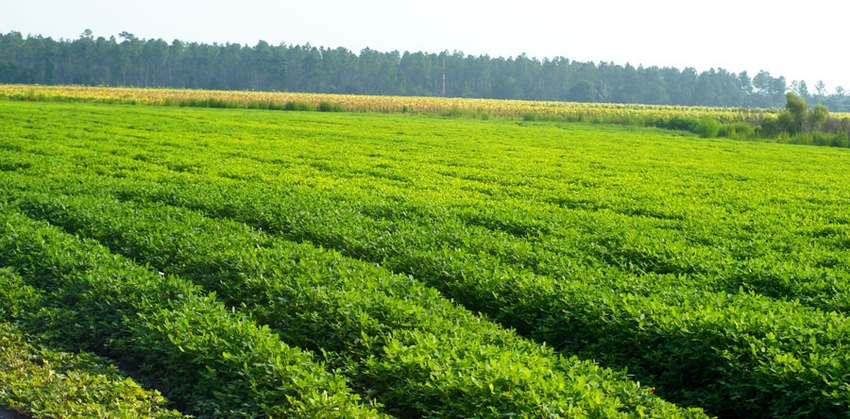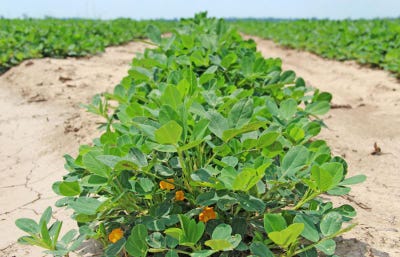
As peanuts have become more a part of the crop mix for many Mississippi farmers, research on insect control has been increasing in order to provide growers more information about the impact of various pests, says Jeff Gore.

JEFF GORE
“I started doing peanut research about five years ago, and this has become a pretty important part of my program,” he said at the annual meeting of the Mississippi Farm Bureau Federation’s peanut policy committee.
Gore, who is associate Extension/research professor at the Delta Research and Extension Center at Stoneville, says this has included projects funded the last couple of years by the Peanut Promotion Board and Mississippi Peanut Growers Association, as well as contract research to evaluate products for chemical companies.
GET AG NEWS DELIVERED DAILY to your inbox: Subscribe to Delta Farm Press Daily
His work has included evaluation of the impact of thrips damage and a potential issue of resistance to Cruiser, which has been widely used across the peanut belt.
“One recommendation from a lot of my research is to use an at-planting insecticide,” Gore says. Among options are in-furrow granular materials such as Thimet 20G and Lorsban 15G (also used T-banded or broadcast); Admire Pro and Orthene, which can be sprayed in-furrow; and CruiserMaxx seed treatment.

LONNIE FORTNER, from left, Port Gibson, Miss., producer and chairman of the Mississippi Farm Bureau Federation peanut committee; Doyle Ferrell, USDA National Agricultural Statistics Service, Belmont, Miss.; and Terry Norwood, Etta, Miss., regional manager for Mississippi Farm Bureau, were among those attending the organization’s summer peanut commodity meeting.
“In 2013, we started seeing less than adequate control of thrips with Cruiser, primarily in cotton,” he says. “Syngenta reported detecting tolerance to Cruiser’s active ingredient in preliminary tests of populations from Arkansas, Louisiana, Mississippi and Tennessee. This is a bigger issue with cotton than peanuts, but I get a lot of questions from growers as to whether they should switch away from Cruiser in peanuts.”
In a 2013 test, he says, with “really heavy pressure” from thrips — from 300 to 500 insects on five plants — after 17 days from planting “the Cruiser treatment was starting to break down in terms of thrips densities, and the Thimet treatment was holding well. The Cruiser-treated peanuts, with 300 thrips on five plants, started looking pretty bad.”
But surprisingly, Gore says, “When we harvested this trial, both of the Cruiser treatments yielded better than the Thimet. There was a pretty big difference.”
At planting insecticide advantage
When any at-planting insecticide was used, the yield advantage was 500 to 800 lbs. or more, and for both Cruiser treatments compared to Thimet alone, there was a 200 lb. to 355 lb. difference.
“So, Cruiser is doing more for us than just controlling thrips,” he says. “It’s also controlling some soil insects, especially in reduced-till situations where there may be wireworms, white grubs, burrowing bugs, etc., already in the soil at planting time. Root feeding by these pests at the seedling stage can have a detrimental impact on yield.
“Even if Cruiser isn’t completely controlling thrips, I wouldn’t give up on it,” Gore says. “There is a whole complex of early season insects, and Cruiser does a good job on most of them. It does seem to be giving us a good advantage in terms of yield. Although it wasn’t in this test, we’ve seen similar results with Admire Pro.”
This year, he’s testing a new compound, Velum Total by Bayer, a combination of Admire Pro and a nematicide. “Velum Total looked better than the same amount of Admire Pro active ingredient, even on thrips. We hope this product will be available in the near future, and we will continue evaluating it.”
In another study, he looked at one, two, and three applications of Orthene for thrips control. “A month after the last treatment, you couldn’t tell the difference between the thrips treatments and the untreated check. We’ll continue this study and take this on to yield and do plant growth measurements. But I’m fairly confident that even a high pressure thrips situation doesn’t hold plants back enough to hurt at the end of the season. That conclusion is similar to what has been found in Georgia research.”
Gore has also looked at the possible interaction between inoculants and insecticides, using various co-applications of Admire Pro, Orthene, Cruiser, and Thimet with an inoculant.
No inoculant-insecticide interaction detected
“All insecticide treatments yielded better than the check,” he says. “We didn’t see a negative yield impact from insecticide treatments applied with the inoculant, compared to the inoculant alone. We don’t think any type of interaction is taking place between insecticides and inoculants, so it’s pretty safe to use whichever you material you want to.”
Work is also under way, Gore says, to evaluate thresholds for three-cornered alfalfa hoppers.
“In our Mississippi Insect Control Guide, we now have a threshold of two hoppers per 10 row feet. Most of the time, if we went by that threshold, we’d be spraying a lot of peanuts four or five times.

Three-cornered alfalfa hopper. — Mississippi Crops photo
“The first thing we wanted to do was to see if hoppers actually reduce peanut yields. In our cage work, we went way above threshold, with 4, 6, and 10 insects per row foot. Where we put the hoppers, we had more peg girdling than on plants with no insects. Most girdling will occur on leaf petioles, which doesn’t do a lot of damage; a very small percentage of their feeding is on pegs.
“In 2009, we had a significant yield reduction, which tells us that the insect can hurt peanut yields in some situations. In 2010, there was no significant difference in yields, but at 4 hoppers per row foot there was a difference of about 600 lbs. There was a lot of variability in our results, and we’re redoing a lot of our work this year, in more realistic situations, to try and better see what’s going on with this pest.”
Defoliating caterpillars complex
There is also a complex of defoliating caterpillars that infest peanuts, Gore says. “It seems every caterpillar in the world loves a peanut plant. These vary by location. In the Delta every year, I seem to get a lot of calls about rednecked peanut worms. They’re tiny worms, and as best I can tell, they don’t do any real damage. They feed a bit in the terminal, and the plants can look a little ragged, but they’re really nothing to worry about.

CATERPILLAR DAMAGE to peanut leaves. — University of Georgia photo
“We also have bollworms, budworms, loopers, and several different cutworm species over the state. Our threshold for worms is 8 per row foot. For cutworms, I think that needs to be a bit lower. I’m looking at Dimilin and Double Take (a Dimilin and lambda-cyhalothrin pre-mix). Double Take did Ok on total caterpillars; on cutworms, it does a lot better. It has very little activity on bollworms and budworms.”
Diamond insecticide, an insect growth regulator, recently received a label for peanuts, he notes, and performed well on total caterpillars last year, although populations weren’t high.
“Diamond could be a good insecticide for us. It doesn’t have great bollworm activity in other crops such as cotton and grain sorghum, but it seems to do a decent job on bollworms in peanuts. Since the bollworms are feeding mostly on leaves, they’re ingesting a lot more of the material in peanuts than in other crops, getting a lot higher dose.
“The pyrethroids don't do a lot for some of the caterpillars we have in peanuts. Granulate cutworms and bollworms won’t be controlled very well with pyrethroids. Belt has been a pretty good insecticide in peanuts, and we now also have Prevathon and Besiege.
“Prevathon does really well in peanuts, reducing caterpillar populations almost to nothing. Intrepid Edge (Intrepid and Radiant mix) could have a fit in some situations. The Radiant component will give good initial knockdown, and the Intrepid component provides good residual control, and does well on cutworms too.”
To develop more accurate thresholds, Gore says, “We’re manually doing 100 percent defoliation at several growth stages — starting at 35 days after planting, we are defoliating select plots every 15 days. Peanuts have a lot of leaves and a remarkable capacity to make up for defoliation. We don’t know what impact these various amounts of defoliation will have on yield, but we will harvest these plots and determine threshold recommendations.”
Spider mites aren’t a huge problem in peanuts, Gore says, “but when they hit they can be pretty devastating, and it doesn’t take very long for that to happen if conditions are right. A worry about spider mites is that we have a lot of areas where the products that are labeled for the pest — Comite II and bifenthrin — won’t control them.
“The best control was with two applications of Comite II at a high rate, but even then we only got about 40 percent to 50 percent control. Last year, I combined Comite II and bifenthrin at different amounts, and where we mixed the two, we got pretty good control of spider mites, almost as good as with true miticides like Oberon. A lot of miticides aren’t labeled for peanuts, so this mix gives us at least an option to get good control of spider mites when we need to treat for them in peanuts.”
About the Author(s)
You May Also Like




